
.NET vs. Node.js: The Ultimate Strategic Backend Comparison for Enterprises
October 08, 2025 / Bryan Reynolds#.NET vs. Node.js: A Strategic Framework for Backend Technology Selection
Part 1: The Performance & Scalability Calculus: From Benchmarks to Business Impact
The selection of a backend technology stack is one of the most consequential architectural decisions a technology leader can make. It has cascading effects on performance, scalability, operational cost, and the very capability of the business to execute its strategy. For years, the choice between .NET and Node.js has been framed by a simple dichotomy: .NET for compute-intensive, enterprise workloads and Node.js for I/O-bound, high-concurrency applications. This report will demonstrate that while this historical framing contains elements of truth, the modern reality is one of significant convergence, demanding a more sophisticated, business-aligned analysis. The decision is no longer about if a platform can handle a task, but how efficiently, cost-effectively, and reliably it does so at scale.
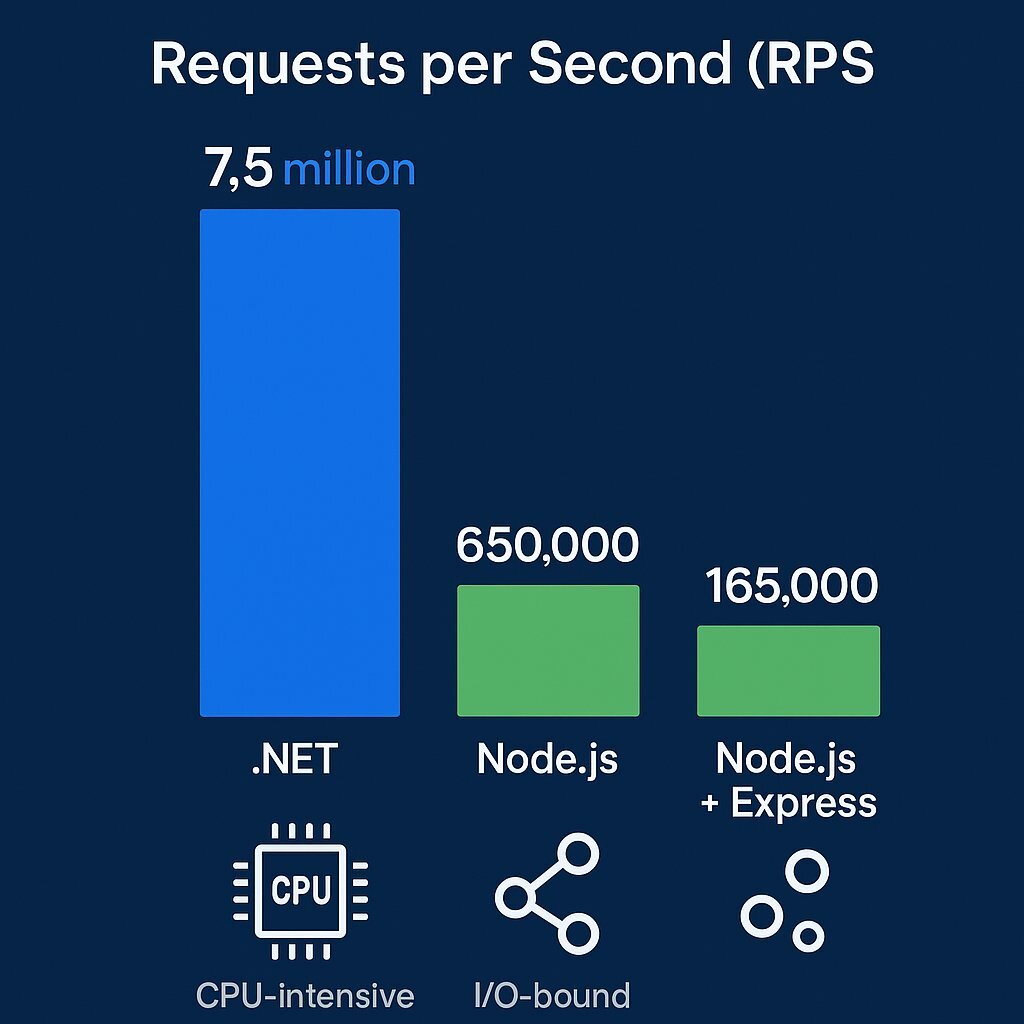
1.1 Deconstructing the Performance Narrative: Beyond "I/O vs. CPU"
The foundational narrative positioned Node.js as the champion of non-blocking I/O, leveraging its event-driven architecture to handle massive numbers of simultaneous connections, making it ideal for real-time applications. Conversely, .NET was seen as the multi-threaded workhorse, excelling at CPU-heavy tasks but historically less adept at I/O-bound concurrency.
This distinction, however, is now dangerously outdated. The introduction of .NET Core (now unified simply as .NET) fundamentally re-architected the platform, introducing a first-class, high-performance asynchronous programming model based on async/await. This Task-based Asynchronous Pattern allows .NET to handle I/O-bound operations with efficiency that rivals Node.js, effectively neutralizing what was once Node.js's primary architectural advantage. Claims that Node.js maintains a unique performance edge due to its non-blocking model are, in the context of modern .NET, based on an "ancient" understanding of the framework that is "not even remotely true today". Both platforms now effectively offload I/O operations, freeing up threads to handle new requests.
With the I/O capabilities having converged, the focus shifts to raw processing speed and efficiency, where a clear gap emerges. Contemporary, independent benchmarks, such as those conducted by Techempower, consistently place ASP.NET at the apex of mainstream, full-featured web frameworks, significantly outperforming Node.js in raw requests per second (RPS). In some tests modeling real-world workloads, the performance differential can be staggering. One analysis points to .NET handling approximately 7.5 million RPS compared to around 650,000 RPS for raw Node.js and a mere 165,000 RPS for Node.js with the Express framework. This performance delta of 10x to 40x is not a mere technical curiosity; it has profound implications for operational expenditure, as will be explored later. This superiority is particularly pronounced in CPU-intensive tasks, where .NET's multi-threaded nature and compiled code offer a distinct advantage.
This is not to say the Node.js platform is stagnant. The underlying V8 JavaScript engine is under continuous development, and recent versions of Node.js have delivered significant performance gains in specific core modules. For instance, comparisons between Node.js v20 and v22 reveal substantial improvements in Buffer operations (with some methods seeing over 100% boosts), URL parsing, and the node:path module. However, this evolution can be uneven, with the same updates introducing notable performance regressions in other areas, such as
node:streams and the zlib module. This highlights a key difference: .NET's performance improvements are often systemic and platform-wide, while Node.js's performance profile can be more volatile and module-specific.
1.2 Architecting for I/O-Bound Concurrency: The Node.js Sweet Spot
Despite the convergence in asynchronous capabilities, the architectural philosophy of Node.js remains uniquely optimized for a specific class of problems. Its core is a single-threaded event loop that orchestrates work. When an I/O operation (like a database query or an API call) is initiated, Node.js does not wait. It leverages the libuv library to pass the operation to an underlying worker thread pool managed by the operating system. The event loop is then immediately free to process the next event. When the I/O operation completes, a callback is placed in a queue, which the event loop processes in a future tick.
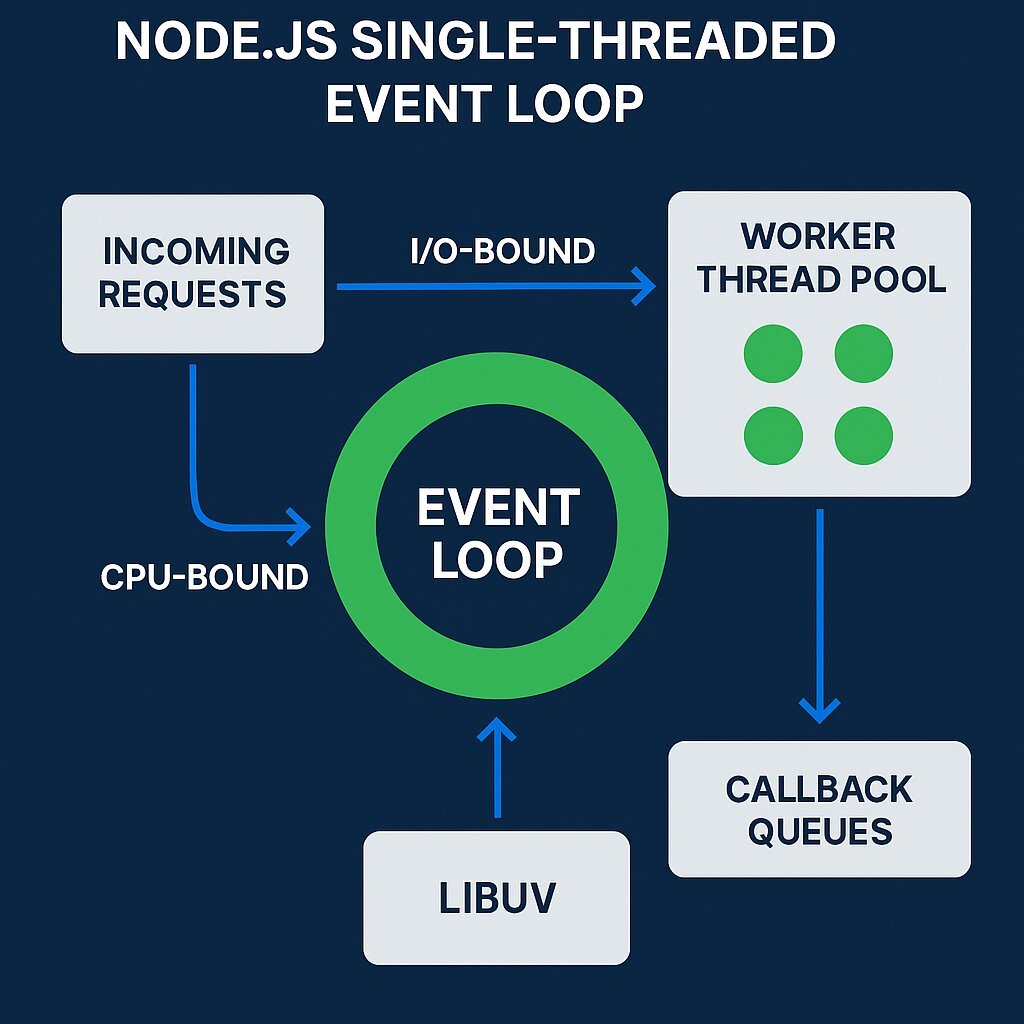
This model is exceptionally lightweight and memory-efficient, allowing a single Node.js process to handle tens of thousands of concurrent connections with minimal overhead. This makes it a strategically sound choice for applications where the primary workload consists of waiting for external resources to respond. Prime examples include:
- Real-time collaboration tools: Chat applications, live-updating dashboards, and online gaming platforms that require persistent, low-latency connections.
- API Gateways and Backend-for-Frontend (BFF) services: Services that primarily aggregate data from other microservices and format it for a client application.
- Single Page Application (SPA) backends: Serving data to rich client-side applications where many small, asynchronous requests are the norm.
This architectural strength is validated by its adoption at massive scale by companies like Netflix, LinkedIn, and Uber, all of whom rely on Node.js to manage millions of concurrent user sessions for real-time updates and data streaming.
However, this architecture also contains a critical vulnerability: the single-threaded event loop is a potential bottleneck. If a task that is CPU-intensive—rather than I/O-bound—is executed on the main thread, it will monopolize the event loop. No other events can be processed until that computation is complete, effectively blocking the entire application and causing it to come to a "screeching halt". While mitigation strategies exist, such as the
worker_threads module, they introduce additional complexity and are an explicit departure from the platform's core architectural pattern.
1.3 Mastering Compute-Intensive Workloads: The .NET Advantage
Where the Node.js model reveals its weakness, the .NET architecture demonstrates its strength. .NET was designed from the ground up for true parallelism, with mature, robust support for multi-threading and the Task Parallel Library. This allows a .NET application to fully leverage the power of modern multi-core processors, executing multiple threads of computation simultaneously without blocking the primary threads responsible for handling incoming requests.
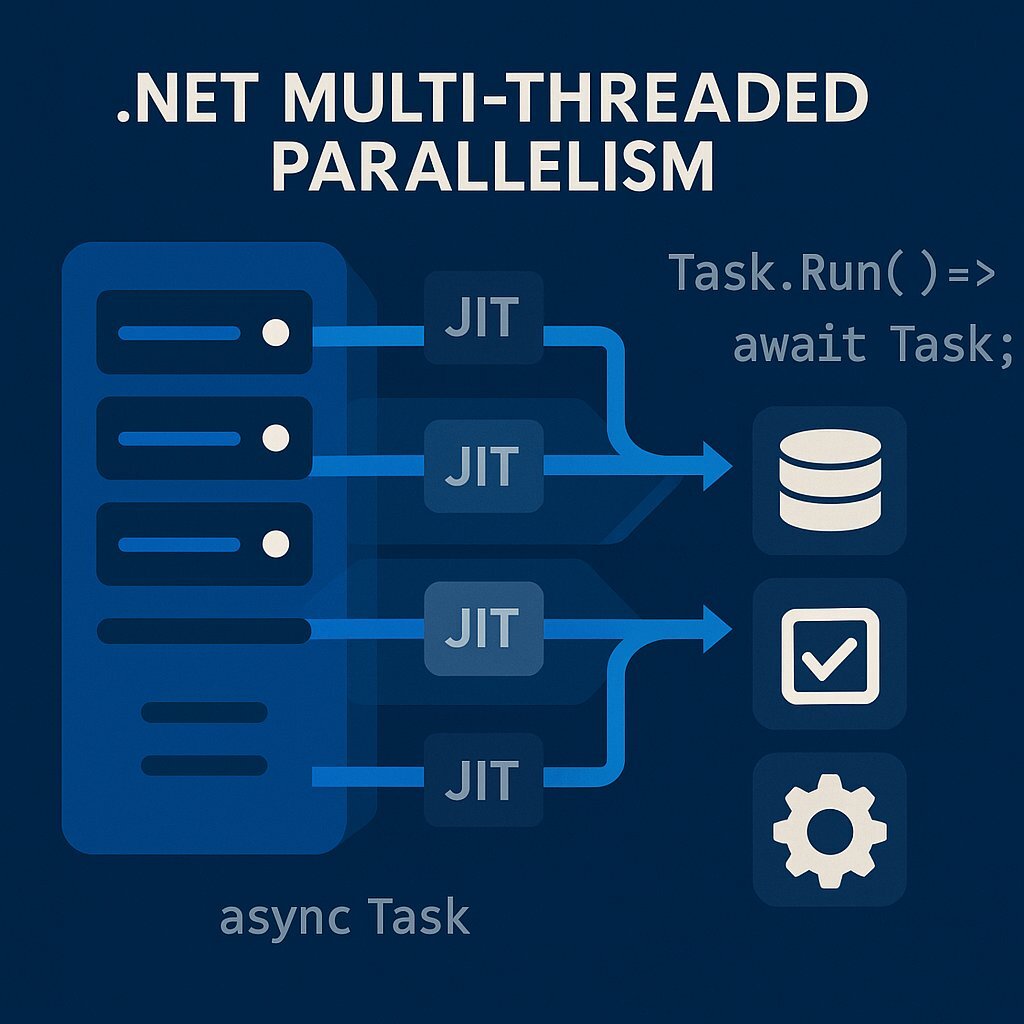
This capability is further amplified by .NET's use of a Just-In-Time (JIT) compiler. When a .NET application runs, its C# code is compiled into an intermediate language (IL), which is then compiled into optimized, native machine code at runtime by the JIT compiler. This compilation step results in code that executes significantly faster than the interpreted JavaScript of Node.js, especially for complex algorithms and data manipulation.
This combination of true multi-threading and compiled code makes .NET the default strategic choice for workloads that are CPU-bound. These include:
- Complex business logic: Financial modeling, risk analysis, and insurance premium calculations.
- Data processing pipelines: ETL jobs, data analysis, and report generation.
- Scientific and engineering applications: Simulations and large-scale numerical computations.
- Backend services for AI and machine learning: Pre-processing data or serving models that require significant computation.
Best practices within the .NET ecosystem dictate that long-running, CPU-bound work should be explicitly offloaded from the request thread to a background thread pool using Task.Run. This ensures that even during intensive calculations, the application's web server remains responsive and can continue to accept and process incoming HTTP requests, maintaining a high quality of service.
1.4 The Economics of Scalability
Both platforms are capable of scaling to meet massive demand, but they do so through different primary mechanisms, which has direct economic consequences.
Node.js is architected for horizontal scaling. The typical pattern is to run multiple instances of the lightweight Node.js application, often in containers, and use a load balancer to distribute traffic among them. This model is exceptionally well-suited to modern cloud-native and serverless architectures.
.NET offers greater flexibility, supporting both horizontal scaling (like Node.js) and vertical scaling. Because of its multi-threaded nature, a single .NET instance can effectively utilize a server with a large number of CPU cores and a significant amount of memory, handling more work on a single machine before needing to scale out.
The critical insight for technology leaders, however, lies in connecting the performance benchmarks from section 1.1 to the total cost of ownership (TCO) for infrastructure. The raw performance of an application platform is not an abstract metric; it is a direct multiplier on infrastructure cost. If a single .NET instance can handle 5 to 10 times the number of requests per second as a Node.js instance on identical hardware, then an organization can serve the same volume of traffic with a fraction of the servers. For a high-traffic enterprise backend consuming significant compute resources, this efficiency difference can translate into millions of dollars in saved cloud hosting costs over the lifetime of the application. This performance-adjusted cost analysis often inverts the common financial assumption, revealing that the platform with higher upfront perceived complexity (.NET) can be dramatically cheaper to operate at scale.
Part 2: The Ecosystem & Developer Velocity Equation
Beyond raw performance, the choice of a backend platform is a long-term commitment to an ecosystem of tools, libraries, and development philosophies. These factors have a profound impact on developer velocity, which must be measured not only by initial time-to-market but also by the sustained productivity and maintainability of a project over its entire lifecycle. The .NET and Node.js ecosystems represent two starkly different philosophies: one prioritizing curated stability, the other championing unparalleled breadth and flexibility.
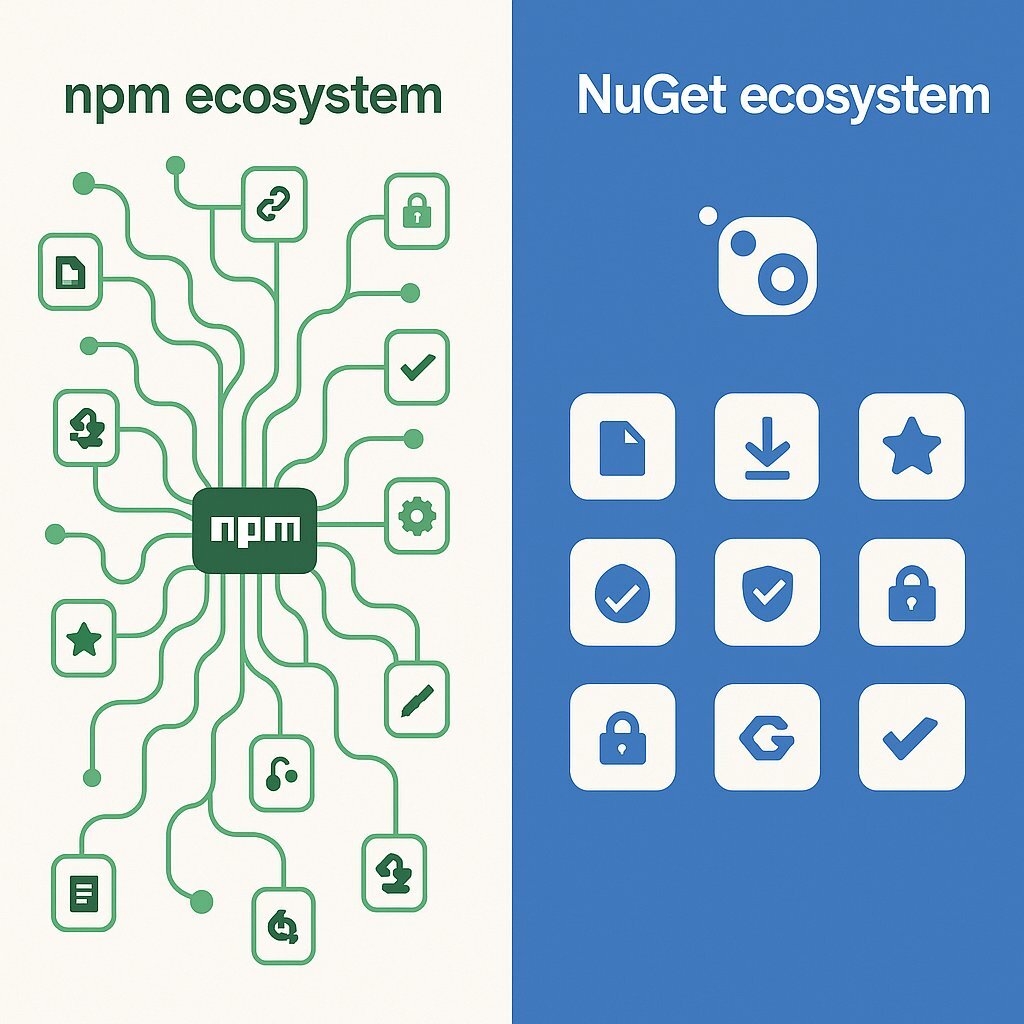
2.1 Ecosystem Philosophy: Breadth vs. Curated Stability
The Node.js ecosystem is defined by npm (Node Package Manager), the largest package registry in the world. It offers a staggering collection of open-source libraries and tools for virtually any conceivable task, from authentication to data manipulation. This vast repository is a powerful accelerator, enabling development teams to rapidly assemble applications by leveraging existing modules, thus avoiding the need to "reinvent the wheel".
However, this immense breadth comes with a significant hidden cost. The quality, security, and maintenance status of npm packages are highly variable. The ecosystem's rapid evolution means that packages can become unmaintained, deprecated, or found to have security vulnerabilities with alarming frequency. This creates a substantial, ongoing maintenance burden often referred to as "dependency hell." For large enterprise applications, a significant portion of developer time can be consumed not on building new features, but on managing this complex and fragile web of dependencies—a task that can require the equivalent of a full-time employee on large projects.
In contrast, the .NET ecosystem, centered around the NuGet package manager, embodies a philosophy of curated stability. While smaller than npm, the NuGet repository is extensive and features a higher proportion of libraries that are built and maintained with enterprise use cases in mind. Core functionalities are often provided by Microsoft itself through a comprehensive Base Class Library, ensuring long-term support, consistent quality, and a predictable release cadence. This leads to a more stable and predictable development experience, which is a critical advantage for large, long-lived applications where stability is paramount.
2.2 Measuring Developer Velocity: Prototyping Speed vs. Long-Term Productivity
The differing ecosystem philosophies directly influence developer velocity. Node.js is almost unrivaled in its speed for initial development. Its lightweight and modular architecture, combined with the vast npm library and the ability to use JavaScript for both frontend and backend, makes it exceptionally fast for building Minimum Viable Products (MVPs), prototypes, and small-to-medium-sized applications. For startups and teams focused on rapid iteration and time-to-market, this is a compelling advantage.
For large, complex enterprise applications, however, the definition of productivity shifts. In this context, .NET's structured and opinionated nature becomes an asset. The strong typing of C#, the comprehensive built-in libraries, and the framework's encouragement of established design patterns (like MVC and Dependency Injection) reduce cognitive overhead and lead to more maintainable, scalable, and testable codebases. Over the long term, development teams may spend less time debugging subtle runtime errors, managing dependency churn, or architecting foundational components, allowing them to focus more on implementing core business logic. The framework itself steers developers toward practices that enhance long-term maintainability.
2.3 The TypeScript Inflection Point
The widespread adoption of TypeScript within the Node.js ecosystem represents a pivotal moment in this comparison. TypeScript, a superset of JavaScript that adds static typing, was developed by Microsoft and has become the de facto standard for building serious, large-scale Node.js applications. Its purpose is to address the primary weakness of JavaScript for enterprise development: the lack of type safety, which can make large applications difficult to maintain and prone to runtime errors.
The rise of TypeScript is an explicit acknowledgment of the value of the development paradigm that .NET and C# have championed for years. It makes Node.js a far more viable and robust option for the enterprise. However, it also fundamentally alters the strategic calculation for technology leaders. The choice is no longer a simple one between a dynamic language and a static language. Instead, the question becomes more nuanced: "If the project's complexity demands the safety and maintainability of a strongly-typed language, is it strategically better to add this capability to the JavaScript ecosystem via TypeScript, or to choose a platform like .NET where strong typing is a native, first-class, and deeply integrated feature of its primary language, C#?". Adopting TypeScript brings the Node.js development experience much closer to that of C#, blurring a major historical differentiator and shifting the focus to the underlying philosophies of the platforms themselves.
2.4 Tooling and the Developer Environment
The developer experience is heavily shaped by the available tooling, and here again, the two platforms offer different approaches.
The .NET ecosystem benefits from world-class, fully integrated development environments (IDEs) like Microsoft's Visual Studio and JetBrains' Rider. These tools provide a powerful, cohesive experience with best-in-class debugging, intelligent code completion (IntelliSense), advanced refactoring capabilities, and integrated performance profiling. This "end-to-end" tooling, particularly when paired with Microsoft's Azure cloud platform, creates a highly productive and streamlined workflow from development to deployment.
The Node.js world, by contrast, is centered around lightweight, highly extensible code editors, with Visual Studio Code (also from Microsoft) being the dominant choice. This approach offers immense flexibility, allowing developers to customize their environment precisely to their liking by assembling a toolchain from a vast ecosystem of extensions for linting, formatting, testing, and debugging. While powerful, this requires more effort to configure and can lead to inconsistencies across a development team. The recent emergence of all-in-one runtimes and toolkits like Bun is a direct response to this fragmentation, aiming to provide a more cohesive and performant developer experience out of the box.
Part 3: Enterprise Readiness: A Framework for Risk Management
For an enterprise, the selection of a technology stack is not merely a technical exercise; it is a strategic decision about managing risk over the long term. Mission-critical systems demand predictability, security, and a clear path for maintenance and evolution. Evaluating .NET and Node.js through this lens reveals that they offer different approaches to mitigating risk. .NET provides risk mitigation through corporate stewardship, integrated features, and ecosystem stability. Node.js offers risk mitigation through open governance, flexibility, and a larger talent pool, but requires the organization to assume more responsibility for operational and ecosystem-related risks.
3.1 Long-Term Maintainability & The Cost of Churn
A critical, often underestimated, component of Total Cost of Ownership is the ongoing cost of maintenance. Here, the philosophical differences between the ecosystems have direct financial consequences.
Developer testimony and industry analysis indicate that maintaining an enterprise-scale Node.js application carries a significant operational "tax". The rapid pace of change and lack of centralized stewardship in the npm ecosystem mean that development teams must dedicate substantial ongoing effort simply to keep the application functional and secure. This includes managing package deprecations, addressing newly discovered security vulnerabilities in dependencies, and refactoring code to accommodate breaking changes in libraries. This is non-feature work that consumes valuable developer cycles and can become a major drag on productivity.
.NET, under the stewardship of Microsoft, offers a fundamentally more stable and predictable proposition. Microsoft provides a public roadmap and a commitment to Long-Term Support (LTS) releases, which guarantee several years of security patches and bug fixes. This predictable cadence allows enterprises to plan upgrades strategically and minimizes the risk of being forced into costly, unplanned refactoring efforts due to ecosystem churn. For organizations that value stability and predictable maintenance costs over bleeding-edge innovation, this is a powerful risk mitigator.
3.2 Security Posture: Integrated Fortification vs. Assembled Defense
Security is a paramount concern in any enterprise application. The two platforms approach security with different philosophies, shifting the burden of responsibility.
ASP.NET Core is designed with a "secure by default" philosophy. It includes a comprehensive suite of built-in security features that provide a robust defensive posture out of the box. These include integrated systems for authentication and authorization (ASP.NET Core Identity), data protection APIs for encryption, built-in protection against common web attacks like Cross-Site Scripting (XSS) and Cross-Site Request Forgery (CSRF), and enforcement of HTTPS by default. This integrated approach reduces the likelihood of common security misconfigurations and lowers the security expertise required of every developer on the team.
Node.js, in its core form, is more minimal. Its security model is highly flexible but requires developers to actively assemble their own defenses using a combination of third-party libraries and best practices. A typical Node.js application will rely on packages like Helmet to set secure HTTP headers, Passport for authentication strategies, and other modules for rate limiting and input validation. While this modular approach can be highly effective when implemented correctly by a security-conscious team, it also carries greater risk. It places a significant onus on the development team to select, integrate, and continuously maintain these disparate security components. The security of the application becomes contingent on the quality of these third-party packages and the diligence of the developers implementing them.
3.3 Corporate Stewardship vs. Community Governance
The governance model of a platform is a key indicator of its long-term trajectory and stability. .NET's development is guided, funded, and stewarded by Microsoft, one of the world's largest technology corporations. This provides enterprises with several key assurances: a clear product roadmap, the option for paid enterprise-grade support, and a single, accountable entity responsible for the platform's health and future. For a risk-averse organization, this corporate backing is a significant asset.
Node.js is governed by the OpenJS Foundation, a vendor-neutral organization that fosters collaborative development from a diverse community of individuals and corporations. This open governance model prevents vendor lock-in and encourages rapid, community-driven innovation. However, it can also lead to strategic drift and fragmentation. The emergence of alternative runtimes like Deno and Bun, for example, can be seen as both a sign of healthy innovation and a symptom of a "headless community" that can be slow to address core enterprise needs. Without a single entity driving a unified vision, the platform's evolution can sometimes feel less focused, leaving enterprises to navigate a more chaotic landscape.
Ultimately, the choice between these models is a choice of risk profile. A CTO must decide whether they prefer the stability and accountability of a corporate-backed ecosystem or the flexibility and innovation of a community-governed one.
Part 4: The Economic Framework: A Modern Total Cost of Ownership (TCO) Analysis
A credible technology decision must be grounded in a comprehensive financial analysis. The Total Cost of Ownership (TCO) for a backend platform extends far beyond initial licensing fees to include talent, infrastructure, and the often-hidden costs of maintenance and operational friction. A modern TCO analysis for .NET and Node.js must first dispel outdated myths and then apply a framework that accounts for the realities of cloud-native development and performance-adjusted costs.
4.1 Dispelling the Licensing Myth
One of the most persistent misconceptions in this debate is that .NET is an expensive, proprietary platform while Node.js is the "free" open-source alternative. This is a relic of a bygone era. Modern .NET (from .NET Core onwards) is a free, open-source platform released under the permissive MIT license. It is fully cross-platform, with first-class support for development and deployment on Linux, macOS, and Windows.
The historical costs associated with the Microsoft ecosystem—namely, mandatory licenses for Windows Server and Microsoft SQL Server—are no longer a factor. Enterprises are free to deploy .NET applications in Docker containers on commodity Linux servers and connect to open-source databases like PostgreSQL or MySQL, incurring zero platform licensing costs. While paid options for tooling (like Visual Studio Enterprise) and databases (SQL Server) still exist, they are entirely optional. For the vast majority of modern, cloud-native use cases, the platform licensing cost for both .NET and Node.js is identical: zero.
4.2 A Comparative TCO Model
With the licensing myth dispelled, a more nuanced TCO model can be constructed. This model must account for the full lifecycle of an application and weigh several key cost categories:
- Talent Acquisition & Retention: The talent pool for JavaScript is undeniably vast, as it has been the most popular programming language in developer surveys for over a decade. This can make it easier and potentially faster to hire Node.js developers. However, C# is also a top-tier, highly popular language, and the supply of experienced .NET developers is robust. While average salaries may show slight variations, for senior talent, the costs are broadly comparable. The most significant factor in this category is often the existing skillset of the in-house team.
- Infrastructure & Hosting (Performance-Adjusted): This is the most frequently miscalculated component of TCO. A simple comparison of the cost of a Linux virtual machine is misleading. As established in Part 1, .NET's superior raw performance means it can often handle significantly more traffic on the same hardware. Therefore, the correct metric is not cost-per-instance but cost-per-million-requests. When calculated on this performance-adjusted basis, .NET can often deliver a substantially lower infrastructure TCO at scale, despite any preconceived notions about the cost of its ecosystem.
- Licensing & Tooling: As noted, the core platforms are free. This category includes optional costs for premium IDEs (e.g., Visual Studio Enterprise, JetBrains Rider, WebStorm) or commercial support contracts. For most organizations, these costs are a minor component of the overall TCO.
- Maintenance & Operational "War Room" Costs: These are the hidden costs that can dominate the TCO of a complex application over time. The higher maintenance burden associated with the Node.js ecosystem—the "dependency hell" and constant churn—translates directly into developer hours spent on non-feature work. Furthermore, the relative stability of the .NET platform and its strongly-typed nature can lead to fewer production incidents and less time spent in high-stress "war room" scenarios, reducing operational friction and improving developer morale and focus.
4.3 Table: 5-Year TCO Projection Template
To make this analysis actionable, technology leaders can use the following template to model the projected 5-year TCO for a new backend service. This framework encourages a holistic view, forcing consideration of both direct and indirect costs.
| Cost Category | .NET Projection Factors | Node.js Projection Factors | Notes |
|---|---|---|---|
| Talent Costs (5-Year) | Avg. Salary x Team Size x 5. Consider C#/F# talent pool. | Avg. Salary x Team Size x 5. Consider JS/TS talent pool. | JS is more popular, potentially larger talent pool. |
| Infrastructure Costs (5-Year) | (VM Cost/hr x Instances) x 24 x 365 x 5. | (VM Cost/hr x Instances) x 24 x 365 x 5. | Crucially, adjust 'Instances' based on performance benchmarks. .NET may require fewer. |
| Licensing & Tooling Costs | Optional: Visual Studio Enterprise, Rider, SQL Server licenses. | Mostly $0. Optional: Paid IDEs (WebStorm). | Core frameworks are free. This cost is often negligible for cloud-native apps. |
| Maintenance Overhead | Lower. LTS releases, stable ecosystem. | Higher. "Dependency hell," ecosystem churn. | Estimate developer-hours per year dedicated to non-feature work. |
| Operational "War Room" Costs | Lower. Stability reduces production incidents. | Higher. Dynamic nature can lead to more firefighting. | A qualitative but critical factor impacting developer morale and focus. |
| Total Estimated Cost (5-Year) | Sum of above | Sum of above |
Part 5: The Strategic Decision Framework & Final Recommendations
The culmination of this analysis is not a single, universal answer, but a framework for making a strategically sound decision tailored to the specific context of an organization. The choice between .NET and Node.js should be driven by business imperatives, risk tolerance, and existing team capabilities. This final section synthesizes the preceding analysis into an actionable decision matrix and provides clear, scenario-based recommendations.
5.1 The Centerpiece: Strategic Decision Matrix
The following matrix translates technical attributes into business outcomes. Technology leaders should identify their highest-priority strategic imperatives and use the matrix to determine which platform offers stronger alignment.
| Strategic Imperative | .NET (C#) | Node.js (TypeScript) | Key Considerations |
|---|---|---|---|
| Maximum Speed to MVP/Time-to-Market | Moderate. Structured framework can be slower for initial setup. | Excellent. Lightweight, vast npm ecosystem, and full-stack JS potential accelerate prototyping. | If the team is already proficient in JS/TS, Node.js is almost always faster for a new project. |
| Mission-Critical Enterprise Stability | Excellent. LTS releases, curated ecosystem, and corporate stewardship provide high predictability. | Good, but requires discipline. Ecosystem churn and dependency management are major risks. | The decision here is about accepting operational risk vs. framework rigidity. |
| Raw Computational Performance | Excellent. Multi-threading and JIT compilation give it a clear advantage for CPU-bound tasks. | Poor to Moderate. Single thread is a bottleneck; requires worker threads as a workaround. | For data processing, ML, or complex calculations, .NET is the superior choice. |
| High-Concurrency I/O (Real-Time) | Very Good. Modern async/await is highly performant. | Excellent. The event loop architecture is purpose-built for this workload. | Both are strong, but Node.js's architecture is philosophically aligned with this problem space. |
| Lowest Infrastructure Cost at Scale | Excellent. Superior performance per-node can dramatically reduce the number of required servers. | Good. Horizontal scaling is easy, but may require more instances to match .NET's throughput. | Do not mistake "free" for "cheap." TCO at scale is a function of performance efficiency. |
| Talent Availability & Full-Stack Synergy | Good. C# is popular, but the JS/TS talent pool is larger. | Excellent. Leverages the massive JavaScript ecosystem and allows for shared code/types with the frontend. | This is often the single most compelling reason for choosing Node.js, especially for web-focused companies. |
| Built-in Enterprise Security | Excellent. Comprehensive, integrated security features out of the box. | Good, but requires assembly. Relies on community packages and developer vigilance. | .NET provides a stronger default security posture, reducing the burden on the development team. |
5.2 Scenario-Based Recommendations
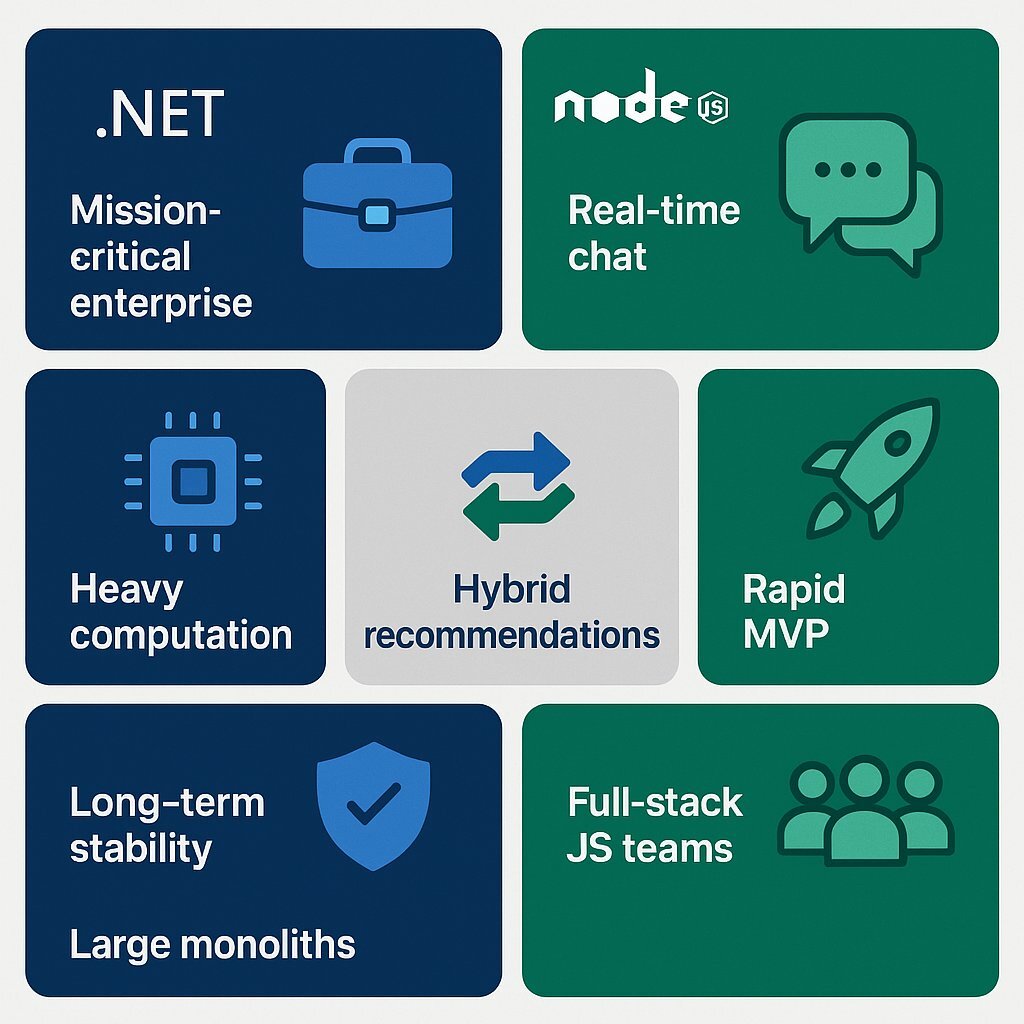
Based on the decision matrix, the following recommendations can be made:
Choose Node.js when:
- Strategic Priority: The primary business driver is speed to market for a new product or feature.
- Team Composition: The development team is deeply skilled in JavaScript and TypeScript, and there is a desire to leverage full-stack development synergy.
- Application Profile: The application is predominantly I/O-bound, such as a real-time chat service, an API gateway, or the backend for a Single Page Application.
- Architectural Strategy: The organization is committed to a microservices architecture where the smaller scope of individual services mitigates the long-term maintenance burden of the Node.js ecosystem.
Choose .NET when:
- Strategic Priority: The application is a mission-critical, long-lived enterprise system where stability, security, and predictable long-term maintenance are paramount.
- Team Composition: The team has existing C#/.NET expertise, or the organization is willing to invest in a platform known for fostering robust and maintainable code.
- Application Profile: The workload involves significant CPU-bound processing (e.g., data analysis, financial calculations) or requires the absolute highest raw performance to minimize infrastructure costs at a massive scale.
- Architectural Strategy: The project is a large, complex monolith or a set of core services that form the backbone of the enterprise, demanding a strong, out-of-the-box security posture and a stable, predictable platform.
5.3 The Hybrid Future: A Concluding Thought
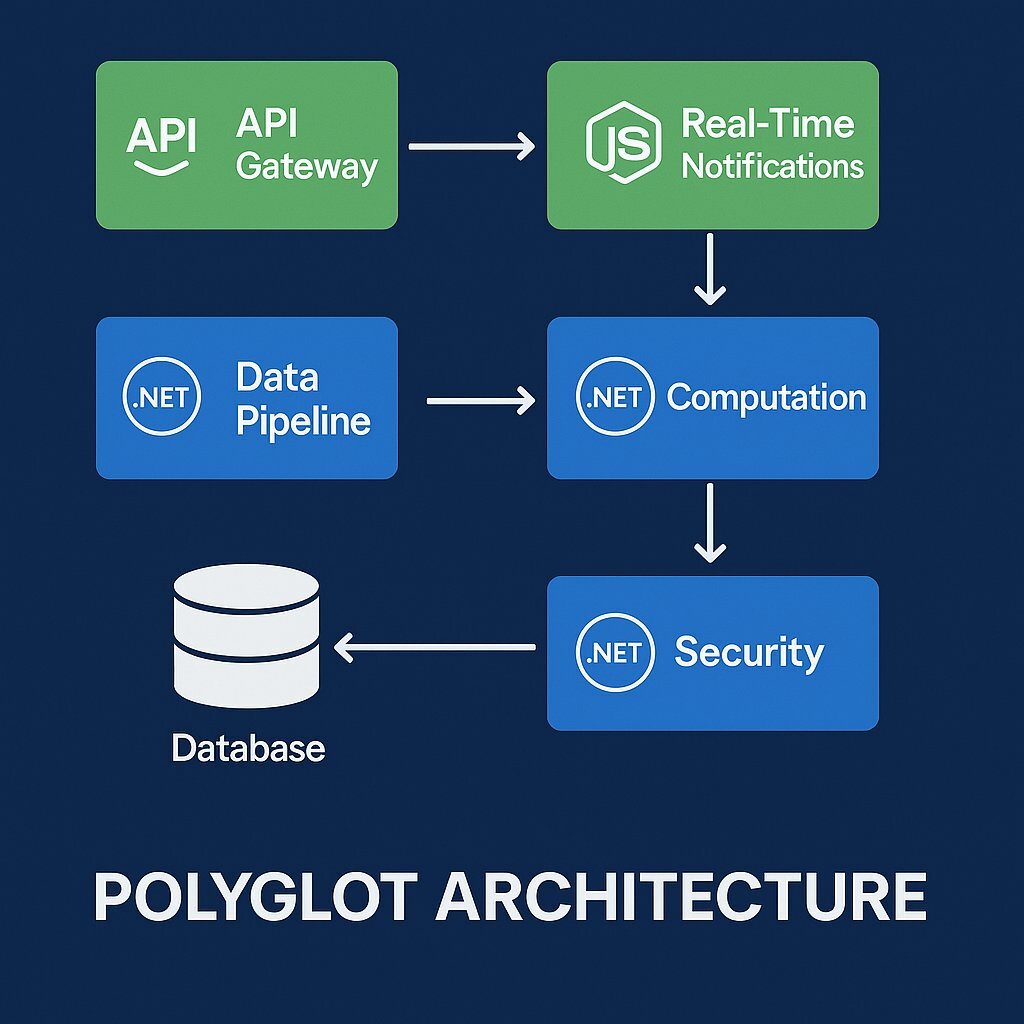
The most sophisticated architectural strategy often rejects a monolithic, all-or-nothing approach. In a modern, distributed system built on microservices, the optimal solution is frequently to use the right tool for the right job. A hybrid or polyglot architecture allows an organization to leverage the peak strengths of both platforms simultaneously.
Consider an architecture that uses Node.js for its public-facing API gateway and real-time notification service, taking advantage of its exceptional ability to handle high-concurrency I/O. Behind this layer, the core business logic, financial transaction processing, and heavy data analysis services could be built with .NET to leverage its superior computational performance, stability, and enterprise-grade security features. For further insights into maximizing ROI, you may find enterprise digital transformation strategies especially useful. This pragmatic, hybrid approach moves beyond technological dogma and focuses on creating the most resilient, performant, and cost-effective system possible by aligning the unique strengths of each platform with the specific business problem it is best suited to solve.
About Baytech
At Baytech Consulting, we specialize in guiding businesses through this process, helping you build scalable, efficient, and high-performing software that evolves with your needs. Our MVP first approach helps our clients minimize upfront costs and maximize ROI. Ready to take the next step in your software development journey? Contact us today to learn how we can help you achieve your goals with a phased development approach.
About the Author

Bryan Reynolds is an accomplished technology executive with more than 25 years of experience leading innovation in the software industry. As the CEO and founder of Baytech Consulting, he has built a reputation for delivering custom software solutions that help businesses streamline operations, enhance customer experiences, and drive growth.
Bryan’s expertise spans custom software development, cloud infrastructure, artificial intelligence, and strategic business consulting, making him a trusted advisor and thought leader across a wide range of industries.


